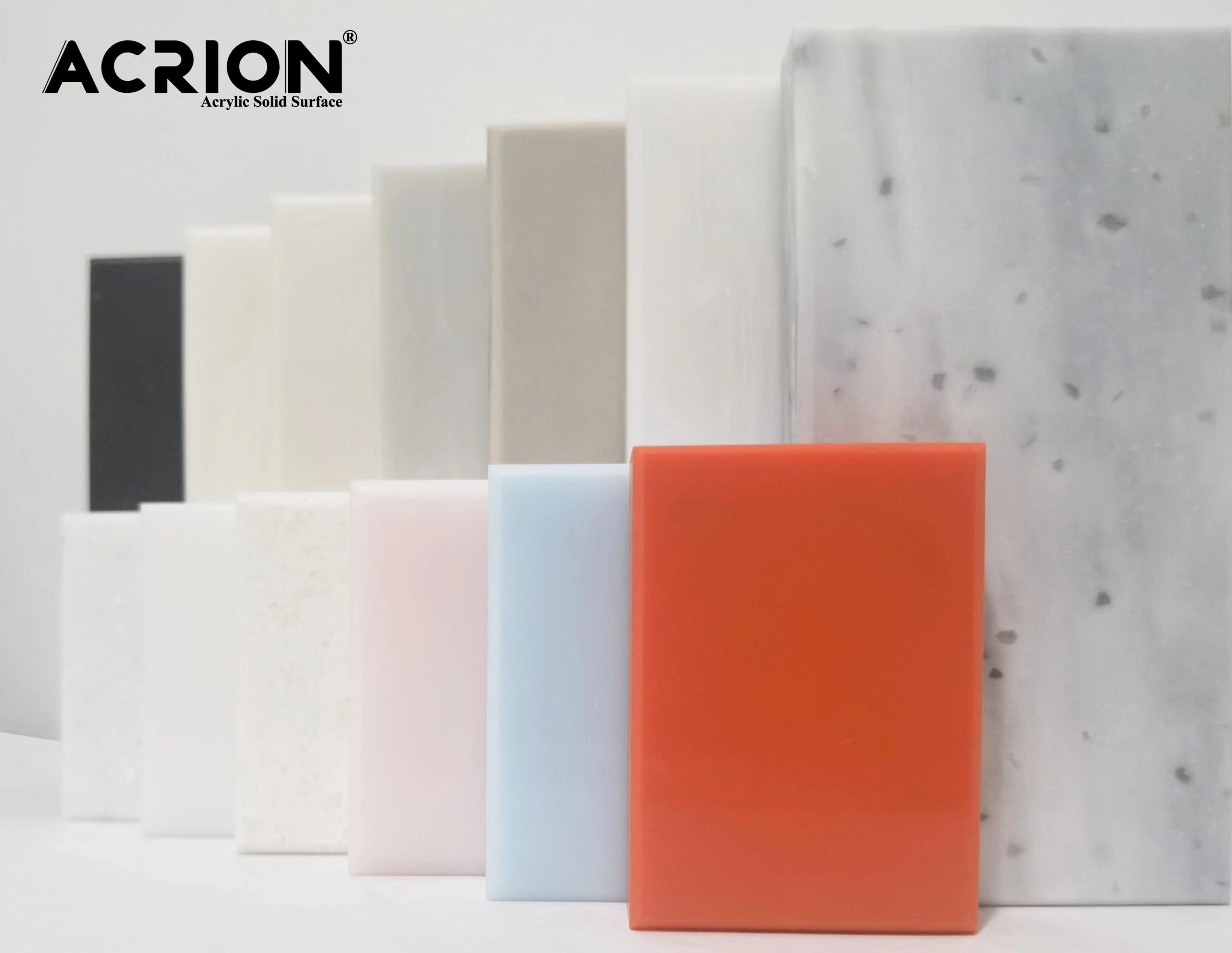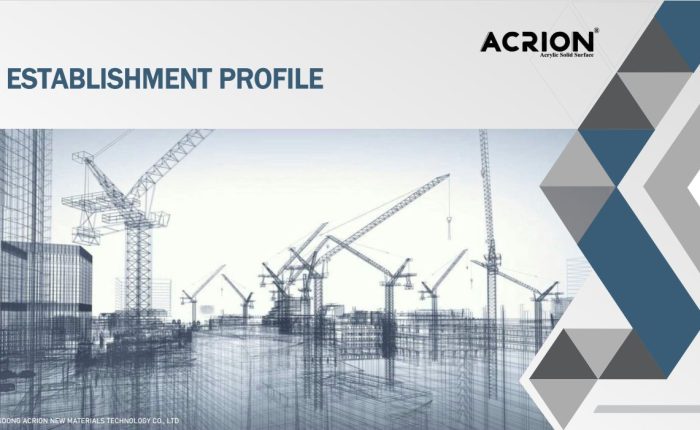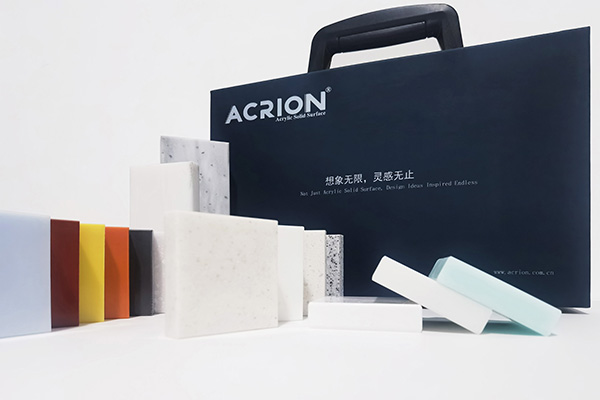Analyse de la flexibilité et de la plasticité des surfaces solides en acrylique
La flexibilité et la plasticité de la surface solide de l'acide acrylique sont influencées conjointement par la structure moléculaire de la résine, le mécanisme de durcissement et les conditions externes. L'analyse suivante est effectuée à partir de trois dimensions: propriétés des matériaux, facteurs d'influence et scénarios d'application:
Premièrement, les sources et les manifestations de la flexibilité
Flexibilité de la chaîne moléculaire
La flexibilité de la résine acrylique dépend principalement de la structure du groupe ester (-coo-) et du groupe alkyle (-r) dans la chaîne principale. Par exemple, l'introduction de groupes alkyle à chaîne longue (comme C8-C12) peut augmenter le volume libre de la chaîne moléculaire, réduire la température de transition du verre (TG) et ainsi améliorer la flexibilité. Si des monomères flexibles (comme l'acrylate de butyle) sont introduits dans la chaîne principale, le revêtement peut résister à 180 ° de flexion à température ambiante sans se fissurer. Cependant, lorsque la proportion de monomères durs (comme le méthacrylate de méthyle) est trop élevée, la fragilité du revêtement augmente considérablement.
L'influence de la densité de réticulation
La posologie des agents de réticulation (comme les diisocyanates et les résines époxy) affecte directement la flexibilité. Par exemple, lorsque la densité de réticulation est trop élevée, le revêtement peut se briser en raison de la concentration de stress pendant le test de flexion. La réticulation modérée (comme un degré de réticulation de 30 à 50%) peut équilibrer la dureté et la flexibilité, permettant au revêtement de maintenir une certaine dureté tout en ayant une résistance à l'impact.
Dépendance à la température
La flexibilité du revêtement acrylique augmente avec l'augmentation de la température. Par exemple, à -20 ℃, le revêtement peut présenter une fracture cassante; À 60 ℃, son allongement à la pause peut augmenter de 2 à 3 fois. Cette caractéristique nécessite que lorsqu'elle est utilisée dans des environnements à basse température, la formule doit être optimisée (comme l'ajout de plastifiants) pour maintenir la flexibilité.
Deuxièmement, le mécanisme de réalisation de la plasticité
Traitement thermoplastique
La résine acrylique incomplètement durcie peut atteindre la plasticité par le traitement thermoplastique. Par exemple, à 120-150 ℃, la résine peut être calendante, moulée par coup ou l'injection, et conserve sa forme après refroidissement. Cette caractéristique est applicable à la fabrication de produits en forme de complexe (comme les pièces décoratives de forme irrégulière), mais la température de traitement doit être contrôlée pour éviter la dégradation thermique.
Façon assistée par solvant
La viscosité de la résine peut être réduite et sa plasticité améliorée en ajoutant des solvants volatils (comme l'acétate d'éthyle). Par exemple, lorsque la teneur en solvant est de 20 à 30%, la résine peut être enrobée ou pulvérisée en une couche mince et un revêtement dense est formé après que le solvant s'évapore. Cette méthode est applicable à la construction à grande échelle (comme les murs extérieurs des bâtiments), mais il est nécessaire de prêter attention à l'influence du taux d'évaporation du solvant sur la planéité du revêtement.
Durcissement léger et réversement réversible
Certaines résines acryliques peuvent être photocurées par des photoinitiateurs, tandis que les liaisons réversibles de réticulation (telles que les liaisons disulfure et les liaisons hydrogène) sont introduites pour améliorer la plasticité. Par exemple, sous une irradiation de la lumière ultraviolette, la résine peut être guéri et formée en quelques secondes. Sous l'influence du chauffage ou des solvants spécifiques, les liaisons de réticulation peuvent se briser, réalisant la mise en forme secondaire. Cette fonction est applicable aux scénarios qui nécessitent un traitement répétitif (comme l'impression 3D).
Troisièmement, les facteurs clés influençant la flexibilité et la plasticité
Composition de monomères en résine
Le rapport des monomères mous (tels que l'acrylate d'éthyle et l'acrylate d'isooctyle) aux monomères durs (tels que le méthacrylate de méthyle et le styrène) affecte directement la flexibilité. Par exemple, lorsque la proportion de monomères mous dépasse 60%, la flexibilité du revêtement est considérablement améliorée, mais la dureté peut être insuffisante. Lorsque la proportion de monomères durs est trop élevée, le revêtement est sujet à la fissuration.
Plastificateurs et modificateurs
Les plastifiants (tels que le phtalate de dioctyle) peuvent réduire les forces intermoléculaires et améliorer la flexibilité. Par exemple, l'ajout de 5 à 10% de plastifiant peut augmenter l'allongement à la rupture du revêtement de plus de 50%, mais il peut réduire sa résistance à la chaleur et sa résistance chimique. De plus, l'introduction de nano-remplateurs (comme la silice et les nanotubes de carbone) peut améliorer la flexibilité et la force par réticulation physique.
Conditions de durcissement
La température et le temps de durcissement ont une influence significative sur la flexibilité et la plasticité. Par exemple, un durcissement à basse température (comme 40 ℃) peut entraîner une réticulation incomplète, ce qui entraîne un revêtement avec une bonne flexibilité mais une dureté insuffisante. Un durcissement à haute température (comme 120 ℃) peut accélérer la réaction de réticulation, augmenter la dureté mais peut réduire la flexibilité. De plus, la flexibilité du revêtement de CV-UV peut être contrôlée en ajustant la concentration du photoinitiateur et l'intensité de la lumière.
Quatrièmement, les exigences de flexibilité et de plasticité dans les scénarios d'application
Revêtement architectural
Les revêtements de mur extérieurs doivent avoir un certain degré de flexibilité pour résister à l'expansion thermique et à la contraction provoqués par les changements de température. Par exemple, dans les zones avec une grande différence de température entre le jour et la nuit, le revêtement doit avoir un allongement à une rupture de 10 à 15% pour empêcher la fissuration. De plus, la plasticité nécessite que le revêtement puisse couvrir également la surface des substrats complexes (comme les murs de briques et la pierre).
Revêtement automobile
Des composants tels que les pare-chocs de voiture doivent être à la fois flexibles et malléables. Par exemple, le revêtement doit maintenir la flexibilité dans la plage de -40 ℃ à 80 ℃, et en même temps pouvoir résister aux impacts mineurs sans décoller. De plus, la plasticité nécessite que le revêtement puisse s'adapter au processus de moulage par injection et former une surface lisse.
Matériaux d'impression 3D
La résine acrylique-acrylique aux UV doit être malléable pour réaliser l'impression de structures complexes. Par exemple, la résine doit guérir rapidement sous la lumière ultraviolette tout en maintenant un certain degré de flexibilité pour éviter la rupture pendant le processus d'impression. De plus, les produits imprimés doivent avoir une force suffisante pour résister à la charge d'utilisation.
Cinquièmement, stratégies pour améliorer la flexibilité et la plasticité
Conception moléculaire
Des segments flexibles sont introduits par copolymérisation ou modification de greffe. Par exemple, l'introduction de segments de polyéther (tels que le méthacrylate de polyéthylène glycol) dans la résine acrylique peut améliorer considérablement la flexibilité tout en maintenant la résistance à l'eau.
Modification composite
Mélanger la résine acrylique avec des élastomères (comme le caoutchouc nitrile, le polyuréthane). Par exemple, l'ajout de 10 à 20% d'élastomère peut augmenter la force d'impact du revêtement de 3 à 5 fois tout en maintenant la transparence.
Processus post-traitement
Optimisez la structure du revêtement par traitement thermique ou recuit du solvant. Par exemple, le traitement thermique à 100 ℃ pendant 2 heures peut libérer la contrainte interne du revêtement et améliorer sa flexibilité. Le recuit du solvant peut favoriser le réarrangement des chaînes moléculaires et améliorer la plasticité.



